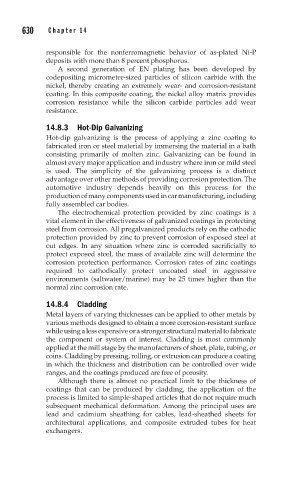Page 676 - Corrosion Engineering Principles and Practice
P. 676
630 C h a p t e r 1 4 P r o t e c t i v e C o a t i n g s 631
responsible for the nonferromagnetic behavior of as-plated Ni-P
deposits with more than 8 percent phosphorus.
A second generation of EN plating has been developed by
codepositing micrometer-sized particles of silicon carbide with the
nickel, thereby creating an extremely wear- and corrosion-resistant
coating. In this composite coating, the nickel alloy matrix provides
corrosion resistance while the silicon carbide particles add wear
resistance.
14.8.3 Hot-Dip Galvanizing
Hot-dip galvanizing is the process of applying a zinc coating to
fabricated iron or steel material by immersing the material in a bath
consisting primarily of molten zinc. Galvanizing can be found in
almost every major application and industry where iron or mild steel
is used. The simplicity of the galvanizing process is a distinct
advantage over other methods of providing corrosion protection. The
automotive industry depends heavily on this process for the
production of many components used in car manufacturing, including
fully assembled car bodies.
The electrochemical protection provided by zinc coatings is a
vital element in the effectiveness of galvanized coatings in protecting
steel from corrosion. All pregalvanized products rely on the cathodic
protection provided by zinc to prevent corrosion of exposed steel at
cut edges. In any situation where zinc is corroded sacrificially to
protect exposed steel, the mass of available zinc will determine the
corrosion protection performance. Corrosion rates of zinc coatings
required to cathodically protect uncoated steel in aggressive
environments (saltwater/marine) may be 25 times higher than the
normal zinc corrosion rate.
14.8.4 Cladding
Metal layers of varying thicknesses can be applied to other metals by
various methods designed to obtain a more corrosion-resistant surface
while using a less expensive or a stronger structural material to fabricate
the component or system of interest. Cladding is most commonly
applied at the mill stage by the manufacturers of sheet, plate, tubing, or
coins. Cladding by pressing, rolling, or extrusion can produce a coating
in which the thickness and distribution can be controlled over wide
ranges, and the coatings produced are free of porosity.
Although there is almost no practical limit to the thickness of
coatings that can be produced by cladding, the application of the
process is limited to simple-shaped articles that do not require much
subsequent mechanical deformation. Among the principal uses are
lead and cadmium sheathing for cables, lead-sheathed sheets for
architectural applications, and composite extruded tubes for heat
exchangers.

